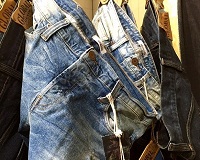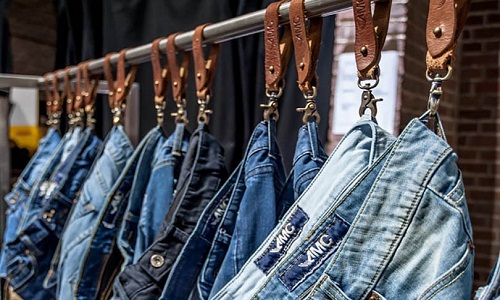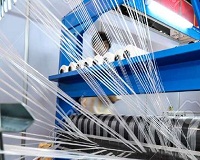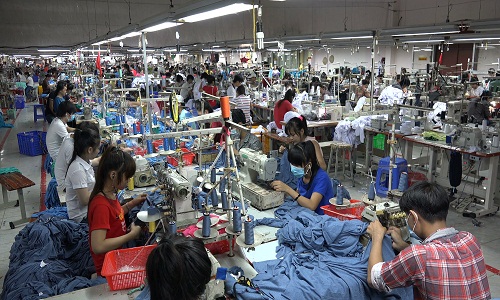FW
"Kingpins New York, held at Basketball City, show cased industry trends in fibre and fabric collaborations, new generations of stretch and recycled materials, and put the sustainability at the forefront. In tune with this, Tricia Carey, Director, global business development for denim at Lenzing, said Lenzing Fibers partnered with DL1961 that uses Lenzing’s Refibra branded lyocell fibres to create a new denim blend for DL1961 jeans that utilises renewable wood sources and employs a supplementary proportion of recycled cotton scraps to create a garment that is sustainable, innovative, but still retains the premium quality, feel and fit."

Kingpins New York, held at Basketball City, show cased industry trends in fibre and fabric collaborations, new generations of stretch and recycled materials, and put the sustainability at the forefront. In tune with this, Tricia Carey, Director, global business development for denim at Lenzing, said Lenzing Fibers partnered with DL1961 that uses Lenzing’s Refibra branded lyocell fibres to create a new denim blend for DL1961 jeans that utilises renewable wood sources and employs a supplementary proportion of recycled cotton scraps to create a garment that is sustainable, innovative, but still retains the premium quality, feel and fit. Thrusting a lot on sustainability, DL1961 is one of the first partners of Lenzing to use Refibra fibers in its denim collection launching for Pre-Fall 2018. DL1961 has been using Lenzing’s Tencel lyocell fibers in its denim since 2012 and has achieved great success in both the industry and with customers as a result.

Lenzing is offering a viable solution with Refibra branded lyocell fibres to provide innovation with reduced environmental impact. Denim is not just about fit and style, it is also about sustainability.
Striking innovations by Core Denim
Cone Denim introduced its new S Gene stretch denim with Repreve. Kara Nicholas, VP-Product design & marketing, Cone Denim, remarked 2017 is the 10th anniversary of the S Gene performance denim, adding significance to the collaborative introduction. S Gene with Repreve combines the advanced stretch technology of S Gene with the superior sustainability and performance of Repreve recycled polyester fiber, offering the most advanced sustainable dual-core stretch denim on the market. Nicholas added the newest addition to Cone’s Sustainblue collection of fabrics maintains the authentic look and feel of traditional denim while offering advanced stretch, recovery and durability in an eco-friendly fabric that is increasingly more important to consumers today.
S Gene with Repreve denim utilises as many as three post-consumer plastic bottles in one pair of jeans. They are designed to offer the next level of sustainable superior stretch to the market and open a wide range of opportunities to denim brands to offer and promote the advanced performance of both S Gene technologies and Unifi Inc.’s Repreve recycled fibers, giving both brands expanded market reach.
Collaborations upping the game
Nicholas points out, collaborations are important for the supply chain. They create products with varied attributes. In continuation, Cone just developed an S Gene style with Thread International, which uses discarded bottles materials to make its Ground to Good fabric. Similarly, Lenzing, Cone and Repreve have also teamed up for True Tone Cone Denim. The collection features Cone’s Future Black+ made with Lenzing Modal Black and Repeve recycled polyester fibers, culminating in a 50-60 per cent lower environmental impact than conventional dyed fabric, fewer chemical energy use and 64 per cent less water use in the dye process.
Jean Hegedus, Global Segment Director for denim, Invista, said Lycra brand is previewing a new T400 that’s sustainable. T400 is two different polymers and in this case, one of them is made from recycled material, and the other is partially made from plant-based materials. At least 65 per cent of the fibre is made from either a recycled or renewable source. A lot of brands and retailers today are looking to tell a sustainable story, and they have lots of options, between BCI cotton, organic cotton or Tencel, but the stretch component was always difficult to make sustainable.
Jack Matthews, Director-sales & marketing, Artistic Denim Mills, opines there is a strong upcycle for denim in all areas of distribution for them. This is led by styling built around performance and fit, and general newness in fabrics. According to him, denim was negatively affected by the athleisure trend until the market took a cue from it and brought in elements related to comfort.
Denim sourcing
Today, sourcing denim is all about speed. By upgrading operations and taking positions on piece goods, Artistic has been able to reduce the cycle from design conception to final shipment to 120 days. More companies are also utilising air freight as part of their overall sourcing plan to being goods to market faster, which brings savings in the long run by having on-trend merchandise in stores and selling more at full price. Scott Gress, President-Denim Marketing, Naveena Denim Mills, said his company has developed Dendrite, a new lightweight synthetic fibre with strong tensile strength and is quick drying, thereby saving on water usage. Naveena is also doing a nylon blended with Dyneema fibre that combines softness with strength in a novelty group.
"Recognised as a highly labour-intensive industry, textile industry has been gaining ground in Southeast Asian countries. Partly being mostly agrarian adds to the advantage as textile requires immense amount of raw materials such as cotton and jute. Coupled with this, high crop subsidies augurs well for growth in the region. China has been sustaining the prime spot for decades now but sheen is slowly getting lost due to ever increasing labour cost, which is favouring other countries such as India, Bangladesh and Vietnam to spot the opportunity and ride growth."

Recognised as a highly labour-intensive industry, textile industry has been gaining ground in Southeast Asian countries. Partly being mostly agrarian adds to the advantage as textile requires immense amount of raw materials such as cotton and jute. Coupled with this, high crop subsidies augurs well for growth in the region. China has been sustaining the prime spot for decades now but sheen is slowly getting lost due to ever increasing labour cost, which is favouring other countries such as India, Bangladesh and Vietnam to spot the opportunity and ride growth. Average labour cost in Bangladesh was $68 per month as against $321 per month in China. The labour costs in India and Vietnam are much cheaper as compared to China. Globally, China is the leader in textiles exports, while India progressively became the 3rd largest exporter of textiles in the world and 5th largest exporter of clothing.
Advantage India

The textile industry in India is pegged at $120 billion and expected to surpass $230 billion by 2020. Inherent advantages include: a strong multi-fibre base (cotton, jute, silk, wool and synthetic), excessive investments, rising disposable incomes and governmental initiatives. In Budget 2016-17, customs duty on raw materials for technical textiles was reduced to as low as 2.5 per cent, this decreased production cost for textile manufacturers. Moreover, initiatives like tax incentives, job security and EPF schemes will make the textile sector more robust. In addition, India also received an FDI of $620 million in 2016-17, this is triple the size of the FDI in 2013-14. India is also in the danger of losing opportunities to Vietnam and Bangladesh, which are quickly establishing themselves with cheap labour. Stats reveal while India saw negative growth of 1 per cent (2015-16), Bangladesh accomplished a growth of 6 per cent owing to the accessibility of cheap labour and its capability in form of big garment factories to process large orders. Garment factories can employ merely 150 people, while garment units in Bangladesh staff around 600 workers. Indian garment factories are not in a position to handle exceptionally large orders due to the size constraints and are losing their business to the counterparts in neighbouring nations.
What works for Bangladesh
The Bangladeshi government does not want to leave any stone unturned to boost growth for clothing manufacturers. The nation’s textile policy 2017 says, the administration will ensure access to duty-free markets, and aid private firms for development of infrastructure and encourage the use of IT in textiles. It will also establish colleges and training institutes to promote local brands in fashion and textiles. However, the government will have to enforce compliance of international standards in manufacturing units, especially in the wake of a recent industrial catastrophe of an outbreak of fire and collapse of the garment factory building. This is required to ensure that cheap manufacturing should not be provided at the cost of the safety and security of workers and good working conditions should not be compromised upon.
Vietnam ventures
Vietnam’s apparel sector also saw an export growth of 10 per cent (2015-16). New foreign investments spurred in the spinning and weaving sectors after the elimination of non-tariff barriers and implementation of Trans-Pacific Partnership Agreement (TPP). Although the USA, which is the biggest importer of Vietnamese textiles and garments has withdrawn from the TPP, the other 11 nations with a combined GDP of $12.4 trillion have agreed to sign the deal. The agreement will help Vietnam to get deep access to the global supply chain, improve its exports and will also reform its labour market. Texhong Textiles (China), Itochu (Japan) and Kyung Bang (South Korea) have all invested in Vietnam to set up spinning and spindle factories. The young labour force in the nation is willing to work at low wages besides a small capital investment is required to set up a factory, this has made Vietnam the hub for setting up of manufacturing factories. Thus, big brands such as Nike and Samsung moved their production from China to Vietnam in the recent years due to the above reason.
Gauging their potential
The future of apparel in Vietnam and Bangladesh looks promising as governments are continuously making attempts to reduce costs and improve sale efforts and are also promoting small and medium-sized firms to grow bigger through various tax incentives and schemes. However, time will tell if they can improve their operational efficiencies to the extent where these nations will be in a position to supersede India in the overall textile market and not only the garment industry.
As per data from the recently published World Trade Statistical Review 20170 by the World Trade Organization (WTO), the current dollar value of world textiles and apparel exports by top 10 countries totalled $246 billion and $384 billion respectively in 2016, falling significantly by $22 billion and $3 billion respectively when compared to the previous year. China remained the leading exporter of textiles in 2016 with a 37 per cent share, despite the fact that its exports fell by 3 per cent. The second spot was taken by the EU with a 23 per cent share, growing by 1 per cent in 2016 and India with a 6 per cent share, showing a fall by 6 per cent. Pakistan rose from ninth to seventh position while Vietnam entered the top 10 for the first time with a 2 per cent share, an increase of 9 per cent.
Over half of the top 10 textiles exporters recorded a decline in the value of their exports with the highest fall of -13 per cent seen by Hong Kong, followed by Taiwan (-8 per cent), South Korea (-6 per cent) and India (-6 per cent), the US (-per cent) and China (-3 per cent).
The top 10 exporters of clothing in 2016 remained the same, however, Hong Kong (China) dropped from fifth to sixth position and India did the reverse by rising to fifth place. China’s exports of clothing fell by 7 per cent but it still stayed in top position by showcasing 36 per cent in value of world exports of clothing in 2016.
EU exports of clothing increased by 4 per cent in 2016, to touch a market share of 26 per cent. The highest increases were recorded by Cambodia and Bangladesh (both by 6 per cent). Exports of China and the US dropped the most by 7 per cent and 6 per cent respectively.
In terms of value, the EU, the US and China were the top three importers of textiles in 2016 accounting for 37.9 per cent of world textile imports. This was followed by Vietnam, Japan, Hong Kong (China), Bangladesh, Mexico, Turkey and Indonesia.
Fast fashion has caught on in Vietnam. Moderate and budget fashion brands like Zara, H&M and Topshop are attractive to young Vietnamese customers. Fast fashion is the practice of rapidly translating high fashion designs into low-priced garments and accessories by mass-market retailers at low costs. Styles no longer follow a four-season fashion calendar but a weekly one.
And Vietnamese apparel manufacturers are embracing the opportunities to meet growing global fast fashion trends and from which to make breakthroughs. Production processes need to be expedited in order to get new trends to the market as quickly and cheaply as possible. As a result, enterprises will face more challenges in design, order and delivery time. The market has to be won over by fast introduction of designs. Firms need to have a good group of designers who can decode the rapidly changing lifestyles and consumers’ choices in fashion and clothing.
To meet the demand and compete with foreign counterparts, local firms must step up investment in modern equipment and attract more skilled workers. Vietnamese firms have for long been familiar with outsourcing contracts for foreign direct investment companies but now they have to make their own products to adapt to new trends.
PVH is looking to acquire at least one more brand. The group is looking for an established brand that has credibility regionally and has potential to have growth and opportunities globally. With Tommy Hilfiger and Calvin Klein, PVH already possesses two of the world's most flourishing fashion brands. For the last quarter, revenues at Calvin Klein grew six per cent, while Tommy Hilfiger rose ten per cent.
Wholesale orders in Europe are up double-digits across both brands for next season, a confidence strengthened by PVH’s development of its Calvin Klein sportswear offering for women in Europe for autumn 2018. PVH’s portfolio also includes Arrow and Van Heusen, part of what it calls its Heritage Brands.
The acquisition of one more brand would be a key evolution in the group’s strategy, following the past few years during which it has been optimizing operations of Calvin Klein and Tommy Hilfiger. PVH has also been focusing on how to take back distribution in several markets in Southeast Asia.
PVH hopes to find the right balance with the third brand which can be put on its operating platforms, Europe, North America, Asia and then Brazil. PVH’s net sales for the second quarter increased six per cent compared to the same period last year.
Pakistan will withdraw sales tax and customs duty on imports of cotton. This is to encourage value addition, reduce the cost of doing business and bridge the gap between production and consumption. Pakistan has been a net cotton importer since 2001. The country produces short to medium staple length cotton which implies that long and extra long staple cotton has to be imported for production of finer yarn counts for subsequent transformation into high value added finished products.
Import of cotton remained duty free till the slab of zero per cent was abolished in 2014-15 and customs duty of one per cent was imposed along with a five per cent sales tax. Duties have an effect on the price of domestic cotton, resulting in an increase in the cost of doing business for the entire textile value chain, especially for the export oriented sector in highly competitive international markets.
The textile industry of Pakistan consumes around 12 to 15 million bales of cotton per annum. The cotton crop for the year 2017-18 is expected to increase 16 per cent compared to last year. The crop that’s arrived at ginning factories as of November 1, 2017, has increased 17 per cent compared to the same period last year.
The Indian denim industry has been operating at 60 per cent to 70 per cent capacity due to a slowdown in demand and over capacity. If the situation continues there can be more production cuts. Denim needs to be cut, sewn and washed before it can be marketed. These upstream activities are majorly done in the unorganized sectors of Delhi, Ulhasnagar and Bellary. These hubs mainly slowed down due to the liquidity crunch in the economy since demonetization and the slow acceptance of GST by small players. As 85 per cent of the fabric is sold in the domestic market, denim fabric mills are badly hit.
Since the upstream activities of garment sewing and washing will take a while to work smoothly with the formal banking system, no recovery of the market in the near future is foreseen. The denim fabric manufacturing industry used to be the sunrise industry in the entire textile value chain of India. Over the last decade, it was growing at a healthy rate of 15 percent CAGR. Currently the industry has an annual installed capacity of 1.5 billion meters, which is the world’s largest, after China. The sales turnover of the industry is estimated to be around Rs 15,000 crores. This industry gives direct employment to five lakh workers.
At present there are 46 denim fabric mills operating in the country. The current domestic consumption of Indian denim fabric is 750 to 800 million meters. Denim fabric export is 200 million meters.
Denim brand G-Star Raw has developed Cradle to Cradle gold level certified jeans. To develop sustainable denim, G-Star partnered suppliers Dystar, Artistic Milliners and Saitex, evaluating the entire design process to identify opportunities to reduce environmental impact.
The result is a denim fabric made from 100 per cent organic cotton, grown without any synthetic fertilizers or toxic pesticides, and the cleanest indigo-dyeing process to-date. The process uses 70 per cent less chemicals, no salts and produces no salt by-product during the reduction or dye process, consequently saving water and leaving clean, recyclable water effluent.
To further enhance product sustainability, G-Star removed all components that could not be easily recycled — such as rivets and zippers — replacing them with eco-finished metal buttons. Additionally, the brand will ensure all labeling and carton packaging are responsibly sourced.
G-Star Raw takes responsibility to lead by example in promoting sustainable denim innovation. G-Star also worked with Saitex to develop new washing techniques that ensure 98 per cent of the water used can be recycled and reused, with the remaining two per cent evaporating, leaving no water left behind to be wasted or released into the environment. The new denim fabric and its revolutionary indigo process will become an open source for the rest of the industry to use.
At Kingpins New York Anubha Industries announced its partnership with Bluesign Technologies to implement a strong chemical management and strengthen their sustainability performance. Anubha is looking at using only clean chemistry in the entire process of denim manufacturing by responsible sourcing using bluesign® approved products. The development of an input stream management in the production process will help them achieve standards for an environmentally friendly and safe production and correspondingly provide customers with sustainable products.
The bluesign® system provides Anubha the bluefinder through which it can access a database of chemicals that are approved by bluesign® to ensure sustainable, high quality and safe materials. Joining the bluesign® system also ensures Anubha key focus on all issues related to the e Environment, Health and Safety and to efficiently work towards sustainability targets.
Aditya Goyal, MD, Anubha Industries exults, “We are proud to become a bluesign® system partner. With laser focused approach on increasing transparency and environmental management performance we are determined to further improve the sustainability of our entire supply chain. We consistently commit to the goal of becoming the most sustainable denim company in India.”
Jill Dumain, CEO at Bluesign Technologies replies, “We are glad to be partnering with Anubha as our first Denim Textile Manufacturer System Partner in India. Anubha has shown its commitment towards sustainable Denim production and we are proud they have chosen bluesign technologies as their partner for chemical management to drive sustainability performance. Together with Anubha, we strengthen our aim to create a responsible Denim supply chain for a more sustainable fashion industry.”
Anubha Industries is a specialist for denim and advanced fabric solutions. Headquartered in Surat, with over 500 employees, the company manages the complete industrial chain from fabric through to finished product.
The bluesign® system is the solution for a sustainable textile production. It eliminates harmful substances right from the beginning of the manufacturing process and sets and controls standards for an environmentally friendly and safe production.
American Eagle Outfitters has joined other US apparel makers in estimating strong earnings for key holiday selling season but said it expected lower profit margins as against a year ago period. Chief Financial Officer Robert Madore said they expect markdowns in promotional environment to remain pretty consistent with last year, which is what we’ve seen in the beginning of the holiday season thus far. The company might be as aggressive on promotions as it was last December, post Aeropostale’s bankruptcy, when it sought to keep shoppers from flocking toward heavily discounted Aeropostale apparel. American Eagle’s gross margin - gross profit as a share of revenue - dropped 1.2 percentage points to 39 per cent in the Q3 ended Oct. 28, due largely to higher warehousing and shipping costs on online orders and enhanced promotions. Despite these drawbacks, American Eagle delivered Q3 earnings and comparable sales ahead of Wall Street targets, driven by strong demand for its Aerie line of lingerie and significantly strong sales for its Aerie brand. Aerie has driven much of the company’s growth in recent quarters.
Comparable sales from the brand rose by 19 per cent in the latest quarter while those for American Eagle marginally moved up by 1 per cent, reversing many quarters of decline. Recent sales at American Eagle have also been driven by newer trends in women’s jeans, helping the company maintain an remarkable 33 per cent share of the U.S. denim market for young shoppers.
Last month, Gap Inc. and Abercrombie & Fitch also forecast strong holiday-quarter earnings, driven by demand for their Old Navy and Hollister apparel. American Eagle’s net income dropped 16 per cent to $63.7 million, stung by promotions and a $14 million charge. Excluding one-time items, the company earned 42 cents per share, topping analysts’ estimate of 38 cents. Revenue rose 2 per cent to $960.4 million. Analysts had expected $960.8 million.












